If there is one manufacturer that has both fed and rode the wave of adventure-tour bike sales these past few decades, it’s BMW. The boxer-twin-powered GS series has been the company’s best-selling model for years, helping fuel the company’s growth as well as allowing it to survive the worldwide economic meltdown relatively unscathed. Thus it’s no surprise that the GS is very important to BMW and has undergone numerous upgrades over the years, with the latest-generation liquid-cooled boxer debuting last year to rave reviews.
Back in 2001, BMW decided to cater to the more serious adventure-tour enthusiast by introducing the GS Adventure model, with various features intended to make it more suitable for overland travel. As each generation of Adventure was introduced, it grew more and more popular, especially in the US, where it now equals or surpasses base model sales. And with the latest 2014 R 1200 GS Adventure, BMW has created a technological marvel that displays the company’s years of experience in the genre it basically created.
The Adventure shares the latest-generation, all-new liquid-cooled boxer engine (actually, only the combustion chambers are liquid-cooled; the cylinders are still air-cooled) with the GS—and the RT featured elsewhere in this issue—sporting twin-cam heads that are rotated to move the intake on top and the exhaust plumbing below. Driveline componentry was shifted around, ditching the old single-plate dry clutch in favor of a transmission that sits inside the engine cases instead of behind, with the multi-plate wet clutch (which has both a slipper function under deceleration and power assist function for easier lever effort) now serviceable in the front without having to split the engine and drivetrain. The more compact engine allowed the airbox shape and intake routing to be refined for better power, while the crankshaft gained 2 pounds for more flywheel effect to smooth out that power. BMW is claiming 15 more horsepower and 3 foot-pounds more torque from the new engine.
The Adventure also gets the same “continuous” tubular steel bridge-type frame as the latest GS, boasting increased rigidity for better handling and feel. The Adventure’s suspension has 0.8 inch more travel on both ends than the base GS (8.3 inches up front and 8.7 inches in back), and the more compact engine allowed a 2-inch-longer swingarm with only an incremental wheelbase increase. All this results in a steeper swingarm angle requiring the fitment of a load damper in the driveshaft, with the steering geometry tightened up accordingly; rake goes from 25.5 to 24.5 degrees, while trail shortens from 3.9 to 3.7 inches. Spoked wheels carry larger 120/70R-19 front and 170/60R-17 rear tires.
Other major differences between the Adventure and base GS include a taller windscreen plus side deflectors, a larger front “beak” that integrates the air intakes and larger side panels for the twin radiators, hand guards and engine/side guards for crash protection, luggage rack, and big, serrated off-road footpegs with adjustable reinforced brake and shift levers.
The Adventure also gets the full electronics suite from the latest GS. The company’s Dynamic Electronic Suspension Adjustment semi-active suspension works in conjunction with ASC (Automatic Stability Control) boasting five riding modes: Rain, Road, Dynamic, Enduro, and Enduro Pro. The ESA has three default settings (Soft, Norm, and Hard; they can be manually changed if desired) depending on the riding mode, and the throttle response/ABS/traction control parameters are also automatically adjusted accordingly.
There’s no getting around the fact that the GS Adventure is a big motorcycle. And tall—with a seat height ranging between 35 to 35.8 inches (tilt adjustable). And heavy—BMW claims a wet (fuel tank “90-percent full”) weight of 573 pounds. Tippy-toe it off the sidestand and get moving though, and the Adventure’s heft disappears for the most part. The bike is far more agile than any near-600-pound/59-inch-wheelbase motorcycle has a right to be. Especially on pavement, where the combination of steep steering geometry, wide and tall handlebar for leverage, and good ground clearance can have the BMW hustling up a tight canyon road at a surprising pace. When the road goes straight, the good wind protection, comfy ergos, huge fuel tank, and smooth, fairly efficient engine mean that gulping down several hundred miles in one stint is not a problem.
Of course, “adventure” equates to continuing where the pavement ends, and BMW had outfitted the press launch bikes with Continental’s superb TKC80 street-legal knobby tires. The ASC’s Enduro and Enduro Pro modes are made for these scenarios, and we found both to work well, though our limited experience off-road riding big ADV bikes meant Enduro was fine for our skill set. BMW’s decades of experience with the bike shone through here with how well the ESA, ABS, and traction control were dialed in to complement each other, allowing the GS Adventure to easily tackle off-road situations that most other ADV bikes would have trouble with. Remember that the BMW is a little top heavy and prefers to be cornered with the throttle on, and you’ll have loads of fun.
There’s a reason why the R 1200 GS Adventure sells so well, and that’s despite its lofty sticker price. While the base model retails for $18,200, BMW says that nearly all customers prefer the $21,550 Premium package, which includes the Dynamic ESA, five riding modes, LED headlight, cruise control, tire pressure monitoring, mounting/wiring for the optional GPS, heated grips, and hard bag mounts.
Specifications
Related articles:










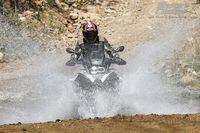
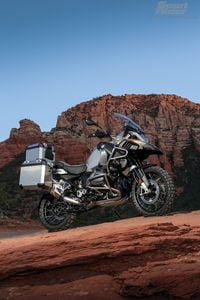
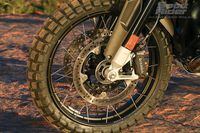
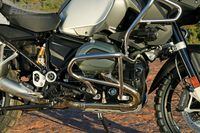
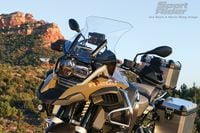
/cloudfront-us-east-1.images.arcpublishing.com/octane/EJJ2JBBSEZAWLFCRDALQOIBFVU.jpg)
/cloudfront-us-east-1.images.arcpublishing.com/octane/WVYKJFMINVFMFH37AE4OUEWVIM.jpg)

/cloudfront-us-east-1.images.arcpublishing.com/octane/JJ3MC6GNDFF5ZNYD3KD3E4EY7Y.jpg)
/cloudfront-us-east-1.images.arcpublishing.com/octane/XH2ETEU4NVGDFNQO2XT2QQS5LU.jpg)
/cloudfront-us-east-1.images.arcpublishing.com/octane/UFG652C27BDBFPK42TDAJ5CMX4.jpg)
/cloudfront-us-east-1.images.arcpublishing.com/octane/AUE3NFVRRZDSBIDVUGIYIDQNUI.jpg)
/cloudfront-us-east-1.images.arcpublishing.com/octane/LYR62CH2WNBMHJJVXVATZHOUE4.jpg)
/cloudfront-us-east-1.images.arcpublishing.com/octane/RBCTRGBQYBDK7A6XPG3HKPS7ZQ.jpg)
/cloudfront-us-east-1.images.arcpublishing.com/octane/MQXQRYMZVBCWJIRYP3HEN3SHVE.jpg)
/cloudfront-us-east-1.images.arcpublishing.com/octane/TSPODNNEWRDSVJGUCNQTDG4ADI.jpg)
/cloudfront-us-east-1.images.arcpublishing.com/octane/X5TB7BDV4BA2RPSY54ZGK27RP4.jpg)
/cloudfront-us-east-1.images.arcpublishing.com/octane/REUHOJXRDBGZ5IHBYZCCBCISPA.jpg)
/cloudfront-us-east-1.images.arcpublishing.com/octane/52LGJTCKBFEHDF7S7H4CVUIMGM.jpg)
/cloudfront-us-east-1.images.arcpublishing.com/octane/YMWAIPIPSJAOXOU3QMJMGH37OM.jpg)


/cloudfront-us-east-1.images.arcpublishing.com/octane/EJ6KZRGAYBCVXNL2PJXL37UVWQ.jpg)
/cloudfront-us-east-1.images.arcpublishing.com/octane/AAN4TI76M5H5JMUVEIGASWXBDU.jpg)
/cloudfront-us-east-1.images.arcpublishing.com/octane/P3RXD2UCPFF37CMB7CHPVKXORY.jpg)
/cloudfront-us-east-1.images.arcpublishing.com/octane/VZEG2EJI2RDFZNHLRZMU56MD3Q.jpg)
/cloudfront-us-east-1.images.arcpublishing.com/octane/GVJQO5FFOFBWNGODOBRB4FBAW4.jpg)
/cloudfront-us-east-1.images.arcpublishing.com/octane/BIVAK2SFIBDJJM25E7I5VU2FJE.jpg)
/cloudfront-us-east-1.images.arcpublishing.com/octane/CH5VX52UG5CFHOVH5A6UYEFWWA.jpg)